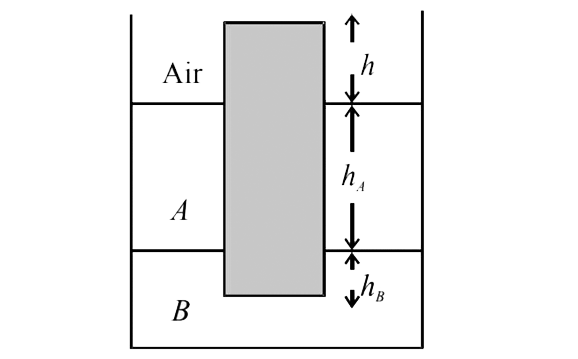A uniform solid cylinder of density 0.8g/cm3 floats in equilibrium in a combination of two non-mixing liquids A and B with its axis vertical.
The densities of the liquids A and B are 0.7g/cm3 and 1.2g/cm3, respectively. The height of liquid A is hA=1.2cm. The length of the part of the cylinder immersed in liquid B is hB=0.8cm.

(a) Find the total force exerted by liquid A on the cylinder.
(b) Find h, the length of the part of the cylinder in air.
(c) The cylinder is depressed in such a way that its top surface is just below the upper surface of liquid A and is then released. Find the acceleration of the cylinder immediately after it is released.
a. Liquid A exerts horizotal force on all area elements for all directions. By symmetry, the resultant of these horizontal force is zero. So the total force exerted by liquid A onn the cylinder is zero.
b. Let A be the cross sectional area of the cylinder.
For floating equilibrium.
Weight of floating cylinder = Buoyant force = weight of liqid displaced.
(h+hA+hB)×A×0.8g=(hAρAg+hBAρBg)
or (h+hA+hB)×0.8=hAρA+hBρB
⇒(h+1.2+0.8)×=1.2×0.7+0.8×1.2
⇒0.8h+1.6=1.8or0.8h=0.2
⇒h=0.25cm
b. Mass of cylilnder =(h+hA+hB)Aρ
=(0.2+1.2+0.8)A×0.8=1.8A
When the cylinder is depressed just completely, its height h goes in liquid B, so extra buoyant fore due to liquid B acts on it. Due to this force cylinder is accelerated upward.
Extra buoyant force F=(hA)ρBg
=0.25A×1.2g=0.3Ag
Acceleration is given by a=Fm=0.3Agm=0.3Ag1.8A=g6
=106=53m/s2
Topper's Solved these Questions
- BOOK - CENGAGE PHYSICSCHAPTER - FLUID MECHANICSEXERCISE - Exercise 4.111videos
FLUID MECHANICS
- BOOK - CENGAGE PHYSICSCHAPTER - FLUID MECHANICSEXERCISE - Exercise 4.211videos
FLUID MECHANICS
- BOOK - CENGAGE PHYSICSCHAPTER - FLUID MECHANICSEXERCISE - INTEGER_TYPE1videos
FLUID MECHANICS
- BOOK - CENGAGE PHYSICSCHAPTER - DIMENSIONS & MEASUREMENTEXERCISE - Integer2videos
DIMENSIONS & MEASUREMENT
- BOOK - CENGAGE PHYSICSCHAPTER - GRAVITATIONEXERCISE - INTEGER_TYPE1videos
GRAVITATION
Similar Questions
A jar contains two immiscible liquids A and B with a coin at its bottom. The depths of liquid A and liquid B are 6 cm and 8 cm, respectively. If the apparent depth of the coin is 9 cm and refractive index of liquid A is 1.5, what is the refractive index of liquid B?
View SolutionA column of water 40cm height supports a 30cm column of an unknown liquid . What is the density of the liquid ?
View Solution
Knowledge Check
- Question 1 - Select One
Choose the most appropriate options.
Argon crystallises in fcc arrangement and the density of solid and liquid Ar is 159g/cm3and1.42g/cm3, respectively. The percentage of empty space in liquid Ar isA34.84%B43.8%C23.4%D21.6% - Question 2 - Select One
The density of a liquid at 100∘C is 8.0g/cm3 and at 0∘C is 8.4g/cm3, the coefficient of cubical expansion of the liquid is
A10−4/∘CB5×10−4/∘CC8×10−4/∘CD4×10−4/∘C - Question 3 - Select One
An object of relative density 0 . 75 is floating in a liquid with 500cm3 of the object inside the liquid . Find the total volume of the object, if the relative density of liquid is 1 . 0 2
A60cm3B680cm3C700cm3D740cm3
Two miscible liquids of densities 1.2gm/cm and 1.4gm/cm aer mixed with a proportion ratio of their volumes equal to 2.5: what is the density of redulting liquid?
View SolutionTwo identical tanks contain water and a liquid of density 0.8gcm−3. Pressure exerted by the liquid is equal to the pressure due to water column of 50 cm. Find the height of the liquid column in the tank ?
View SolutionTwo immiscible of densities 2.5g/cm3 and 0.8g/cm3 are taken in the ratio of their masses as 2:3 respectively find the average density of the liquid conbination.
View SolutionTwo identical containers A and B are filled with two different liquids of equal masses. The level of the liquid in container A is found to be one-fourth of the level of the liquid in container B. What is the ratio of thedensity of two liquids? If the density of he liquid in the container A is 2 " g "cm−3, then find the density of the mixture of the two liquids.
View SolutionWhen 100 drops of a liquid P is added into a liquid Q the volume of the liquid in the container which is initially filled with liquid Q doubled. Determined density of the mixture if density of the liquids P and Q are 1.5 g cm ^(-3) and 1.3 g cm^(-3), respectively
View Solution

